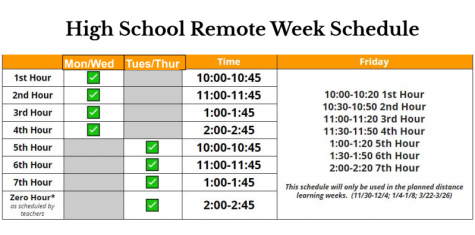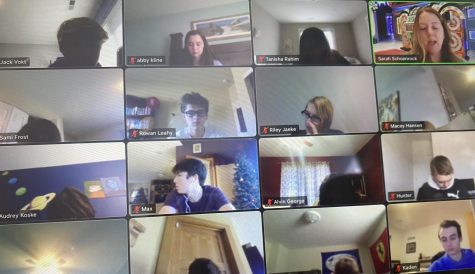Elkhorn Public Schools installed a remote week after Thanksgiving, Christmas, and Spring Break to help prevent the spread of Covid-19. The first remote week was after Thanksgiving, students and teachers formed strong opinions on this.

The remote week schedule had its benefits, but it also had some drawbacks according to students and teachers.
The obvious benefit to both teachers and students was the late start and shortened days. Macey Hansen, a junior at Elkhorn North said the late start was one of the best parts of the remote week. “It was nice being able to sleep in and not have to go to every class,” Hansen said. She was able to manage her time too while having the shortened schedule so it was definitely a win for her.
Zach Moresette, a junior, also saw the schedule as a benefit. He believed it was better because he didn’t have to wake up three hours earlier to get ready to be at school on time. “I could roll out of bed at 9:30 and still be to class on time,” Moresette said.
The students got to enjoy this sleeping schedule while some teachers did not. “ I come to school at 7:30 to get ready for the day,” Mrs. Peterson said. She liked to come in early on some days to get some of the online work done and be prepared for her students, but when she got the chance, she took advantage of the later start.
Although the schedule was shorter, students felt like they were still given the same amount of workload. Both Moresette and Hansen said that their teachers assigned pretty much the same workload which was maybe not what they were expecting. As for teachers, it just depended on the class and what they had planned. For example, Mrs Peterson had to take her classes in a different aspect due to the ability of the class, and the class subject in general. Some classes she just assigned a project to be done, while other classes she had to assign a bit more to keep them on track.

The benefits and drawbacks of the remote week had a significant impact on students and teachers.
“It’s harder because you are less motivated and focused to get school work done,” Moresette said. Many distractions such as TV, phone, siblings, and friends can cause it to be harder during remote weeks. Other issues can be turning in assignments online through Google Classroom, and internet connection. Uploading pictures and documents can be hard, and can be hard to remember to upload.
Also, internet connections can be bad in households where multiple kids are trying to use Zoom, leading it to crash. Teachers were very understanding of this though. Mrs. Peterson said that when students were kicked out they knew how to get back on, and they were great with technology issues.
Coming back from a remote week can be hard after getting used to sleeping in and enjoying getting off early. It can take some getting used to by the students, but the teachers are happy to be back more than anyone else. “Absolutely yes,” Mrs. Peterson said when asked about being ready to return in person. “I’d much rather see people’s faces in person.”
With this being the first remote week during the school year, there were benefits, disadvantages, technical difficulties, and the realization that in-person learning may be the best option.










